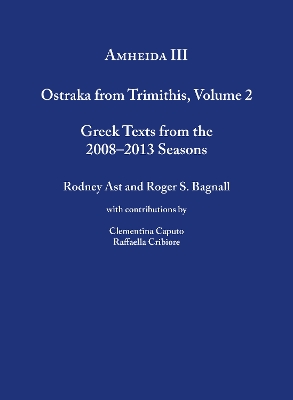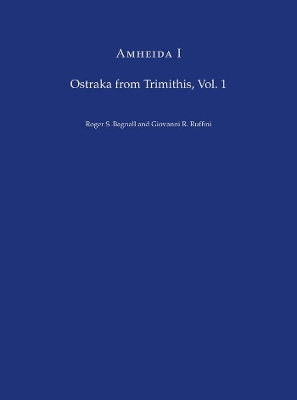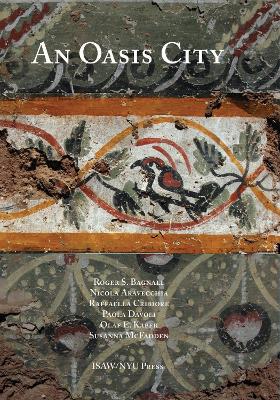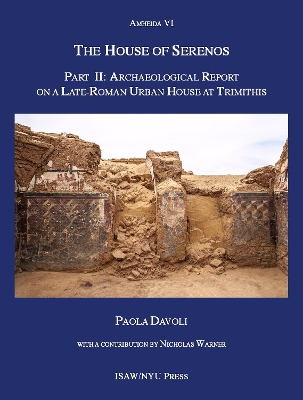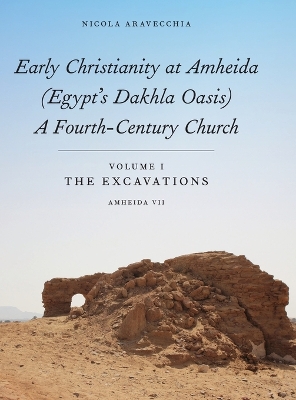ISAW Monographs
6 total works
This archaeological report provides a comprehensive study of the excavations carried out at Amheida House B2 in Egypt's Dakhleh Oasis between 2005 and 2007, followed by three study seasons between 2008 and 2010. The excavations at Amheida in Egypt's western desert, begun in 2001 under the aegis of Columbia University and sponsored by NYU since 2008, are investigating all aspects of social life and material culture at the administrative center of ancient Trimithis. The excavations so far have focused on three areas of this very large site: a centrally located upper-class fourth-century AD house with wall paintings, an adjoining school, and underlying remains of a Roman bath complex; a more modest house of the third century; and the temple hill, with remains of the Temple of Thoth built in the first century AD and of earlier structures. Architectural conservation has protected and partly restored two standing funerary monuments, a mud-brick pyramid and a tower tomb, both of the Roman period.
This is the second volume of ostraka from the excavations Amheida (ancient Trimithis) in Egypt. It adds 491 items to the growing corpus of primary texts from the site. In addition to the catalog, the introductory sections make important contributions to understanding the role of textual practice in the life of a pre-modern small town. Issues addressed include tenancy, the administration of water, governance, the identification of individuals in the archaeological record, the management of estates, personal handwriting, and the uses of personal names. Additionally, the chapter "Ceramic Fabrics and Shapes" by Clementina Caputo breaks new ground in the treatment of these inscribed shards as both written text and physical object. This volume will be of interest to specialists in Roman-period Egypt as well as to scholars of literacy and writing in the ancient world and elsewhere.
This volume presents 455 inscribed pottery fragments, or ostraka,
found during NYU's excavations at Amheida in the western desert of Egypt. The
majority date to the Late Roman period (3rd to 4th century AD), a time of rapid
social change in Egypt and the ancient Mediterranean generally. Amheida was a
small administrative center, and the full publication of these brief texts
illuminates the role of writing in the daily lives of its inhabitants. The
subjects covered by the Amheida ostraka include the distribution of food, the
administration of wells, the commercial lives of inhabitants, their education,
and other aspects of life neglected in literary sources. The authors provide a
full introduction to the technical aspects of terminology and chronology, while
also situating this important evidence in its historical, social and regional
context.
Online edition available as part of the NYU Library's Ancient World Digital Library and in partnership with the Institute for the Study of the Ancient World (ISAW).
Oasis City, An
by Roger S. Bagnall, Nicola Aravecchia, Raffaella Cribiore, Paola Davoli, Olaf E. Kaper, and Susanna McFadden
Scattered through the vast expanse of stone and sand that makes up Egypt’s Western Desert are several oases. These islands of green in the midst of the Sahara owe their existence to springs and wells drawing on ancient aquifers. In antiquity, as today, they supported agricultural communities, going back to Neolithic times but expanding greatly in the millennium from the Saite pharaohs to the Roman emperors. New technologies of irrigation and transportation made the oases integral parts of an imperial economy.
Amheida, ancient Trimithis, was one of those oasis communities. Located in the western part of the Dakhla Oasis, it was an important regional center, reaching a peak in the Roman period before being abandoned. Over the past decade, excavations at this well-preserved site have revealed its urban layout and brought to light houses, streets, a bath, a school, and a church. The only standing brick pyramid of the Roman period in Egypt has been restored. Wall-paintings, temple reliefs, pottery, and texts all contribute to give a lively sense of its political, religious, economic, and cultural life. This book presents these aspects of the city’s existence and its close ties to the Nile valley, by way of long desert roads, in an accessible and richly illustrated fashion.
The fourth volume in the Amheida series, 'Ain el-Gedida: 2006-2008 Excavations of a Late Antique Site in Egypt's Western Desert (Amheida IV) presents the systematic record and interpretation of the archaeological evidence from the excavations at 'Ain el-Gedida, a fourth-century rural settlement in Egypt's Dakleh Oasis uniquely important for the study of early Egyptian Christianity and previously known only from written sources.
Nicola Aravecchia (Washington University), the Deputy Field Director of NYU's Amheida Excavations, offers a history of the site and its excavations, followed by an integrated topographical and archaeological interpretation of the site and its significance for the history of Christianity in Egypt. In the second half of the volume a team of international experts presents catalogs and interpretations of the archaeological finds, including ceramics (Delphine Dixneuf, CRNS), coins (David M. Ratzan, NYU), ostraca and graffiti (Roger S. Bagnall, NYU and Dorota Dzierzbicka, University of Warsaw), small finds (Dorota Dzierzbicka, University of Warsaw), and zooarcheological remains (Pamela J. Crabtree, NYU and Douglas Campana).
A comprehensive study of the archaeology of the House of Serenos
The House of Serenos, Part II is the second of four books devoted to publishing the archaeology of the House of Serenos, a richly decorated, late antique villa of a local elite, located in Amheida (ancient Trimithis) in the Dakhla Oasis of Egypt. The House of Serenos, Part II synthesizes the archaeological information presented in detail in other volumes in a comprehensive study of the architectural and archaeological history of the house and its relationship to its natural and built environments, from construction through expansion and renovation to its eventual abandonment around the end of the fourth century. The volume includes discussions of archaeological method, stratigraphy, architecture, and the archaeological assemblages discovered in the House of Serenos-and reveals what all this can tell us about the inhabitants and their experience living in this high-status residence at the edge of the Roman Empire.
Early Christianity at Amheida (Egypt’s Dakhla Oasis), A Fourth-Century Church
by Nicola Aravecchia
An archaeological, historical, and art historical study of a remarkable early church excavated at Amheida in Egypt's Dakhla Oasis
Early Christianity at Amheida (Egypt’s Dakhla Oasis): A Fourth-Century Church. Volume 1: The Excavations is an archaeological, historical, and art historical study of a remarkable basilica-church excavated at Amheida in Dakhla Oasis. This church, excavated between 2012 and 2023, dates to the fourth century CE and therefore is among the earliest purpose-built churches in Egypt. It also contains one of the oldest, if not the oldest, excavated Christian funerary crypts in the country. The church at Amheida thus offers a wealth of new data on early Christianity in Egypt, particularly with respect to the earliest phases of Christian art and architecture and burial customs. Aravecchia presents a systematic treatment of the stratigraphy, building techniques, materials, features, architecture, decoration, and finds of the church, carefully contextualized in the early Christianity of the late antique Great Oasis and Egypt more broadly.
